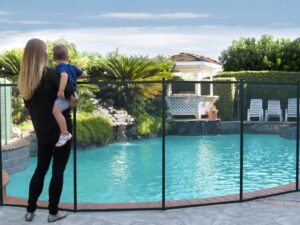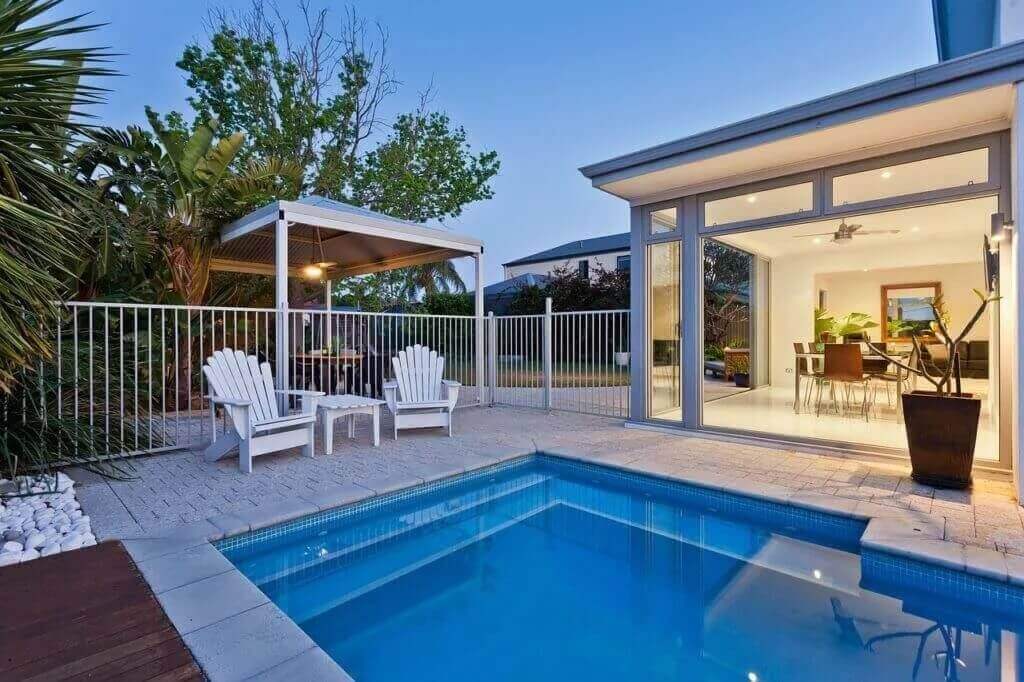
What Makes a Pool Fence Truly “Child-Safe”?
A truly child-safe pool fence does more than meet code. Discover the features parents should prioritize, and how All‑Safe builds fences that families trust.

A tall pool fence deters children and others who are at high risk of injury or drowning from entering your pool area unsupervised. The ideal pool fence height for a tall enclosure is determined by several factors, from state laws that protect millions of people to homeowners association (HOA) bylaws that concern the welfare of just a few. Choosing a height is like answering a multiple choice question in which only one answer may be right for your pool.
Additionally, your pool may have multiple pool fences, such as a permanent fence and a removable pool fence.
Because various levels of governance require homeowners to erect permanent pool fences and also because many residents require a removable pool fence to help protect loved ones, let’s examine information that can help suggest the ideal height for both types of fences.

A pool fence height of four or five feet is also a popular choice for a temporary residential pool fence. That height is tall enough to considerably deter small children and pets from entering the pool and hurting themselves.
Mesh fencing is the most popular and effective for residential pools and comes in two primary designs: Ultra Mesh Pool Fence and Classic Mesh Pool Fence. Customized for the pool it serves, each type securely mounts on the pool deck. You can also include a self-closing, self-latching gate that may lock with a key.
If you live in an HOA, any standards that regulate pool fence height and other elements of the fence are contained in your community’s Declaration of Covenants, Conditions, and Restrictions (CC&Rs).
Some CC&Rs are exceptionally thorough, covering nearly every alteration a property could receive. Some communities assertive ensure that CC&Rs are honored, Conversely, others check compliance infrequently. In some instances, this is because time-strapped HOA board members handle compliance in place of a third-party HOA management organization.
Even if you live in an HOA community where compliance citations are rare, don’t assume that your new pool fence will go unnoticed. Check your community’s CC&Rs to avoid receiving a surprise citation.
Standards for pool fence height are primarily set by state, county, and city regulations, which vary by location. Variance often reflects how these entities respectively use a “base code standard,” such as the International Building Code (IBC), to define the regulatory process.
Standards can also differ due to local pool drowning statistics and jurisdictional liability claims that involve plaintiffs scaling pool fences. In addition, a pool drowning that is considered especially tragic has been known to significantly tighten standards at the city level, as well as at the county and state levels, if the incident is perceived as one that raises awareness.
These factors, among others, help inform pool fence height standards at state, county, and city levels. However, when deciding how tall a pool fence should be, regulators often establish a height range. Choosing a specific is left to the discretion of homeowners.

Could adopting an “ideal” pool fence height simplify and economize the regulatory process, saving time and money by reducing violations and the resolution process? Regulators may never know. They seem to associate economic benefit with using a height range instead.
A “minimum requirement” height standard that offers a generous height range is common.
Support for a safer, taller pool fence that has a single height standard isn’t as relevant to the norms of the regulatory process as one might think. However, an industry that thrives on refined numbers analysis—the insurance industry—can provide some helpful support.
According to Signs.com, a supplier swimming pool signage and other types, “Almost all insurance companies require policyholders to erect pool fences that meet certain criteria such as height (4 feet is most common).”
Because insurance companies hedge their bets on statistics and not speculation, it’s reasonable to assume that a pool fence height of four to five feet deters death and injury more than enough to be in an insurer’s best interest. Considering that plaintiffs have more leverage in residential swimming pool claims than in claims against public pools and that insurers seem likely to approve a fence in this height range makes an even more compelling case for choosing a pool fence height from within this range.
A fence that’s five feet high isn’t short, but it is low enough for most adults to have a view over the top. All things considered, the ideal height for a permanent residential pool fence is about five feet.
If you have a home swimming pool, and residents or visitors of your place pose a high drowning risk, implementing a sufficiently tall pool fence from All-Safe could save a life as well as spare you from a costly legal situation. To schedule a swimming pool inspection and estimate to install a removable pool fence, contact your local All-Safe dealer today.

A truly child-safe pool fence does more than meet code. Discover the features parents should prioritize, and how All‑Safe builds fences that families trust.

Thinking of installing your own pool fence? Discover the benefits of DIY kits, from cost savings and flexibility to safety compliance, and how All‑Safe makes it possible.

Just got a pool? Learn what every new owner should know, from safety codes and barrier options to basic upkeep and seasonal preparation.
Enter your zip code to locate an independent installer in your area
Enter your zip code to locate an independent installer in your area
Their contact info will be shown on the next screen.
Due to the many variations in monitors, phones, and browsers, color samples and product examples may appear different on different screens. Computers and mobile devices are not all calibrated equally and color reproduction on the Internet is not precise. The same is true for printed items such as brochures and other sales literature.
In addition, the colors of our products photograph differently under different lighting conditions. For example, photos taken in full sunlight will vary from photos taken on a cloudy or overcast day. Similarly, shadows from nearby objects can affect the color and transparency of our products. If a precise color or specific shade is important, please inspect the actual color of your product prior to installation.
Many of our products’ materials are not available through typical stores and vendors and therefore must be custom manufactured specifically for our use. In order to control costs and provide you with the best value possible, our raw materials are produced in large batches and can often take several months to receive. The colors of our materials can, and often do, vary slightly from batch to batch. Although we make every effort to minimize color variations, we cannot be responsible for these differences when they occur. If a precise color or specific shade is important, please inspect the actual color of your product prior to installation.
For example, we use the name “putty” to describe some of our products. Your idea of the color “putty” may be different than someone else’s idea of “putty”. In addition, products may have the same color name but may not be the exact same color. For example, we have different shades of “black”. Please do not order using color names as your only guide. If a precise color or specific shade is important, please inspect the actual color of your product prior to installation.
If it is important that your product be an exact color or shade, it is highly recommended that you inspect the actual product prior to its installation and address any concerns with your local independent installer. Most independent installers do not offer refunds or accept returns due to color variations.